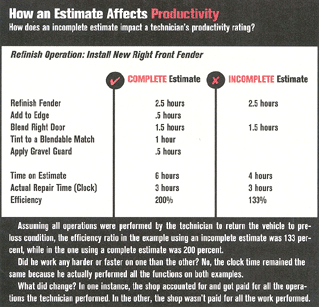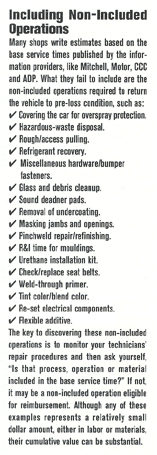It’s not that shops write bad estimates. But by including common operations performed by technicians but often forgotten on the estimate, you can improve your shop’s performance and profits – no matter what region of the country you’re located in.
Consider these examples from students who’ve attended my estimating class:
- A shop owner in South Carolina reported improving his average repair order from about $2,000 to $2,400 after applying several of the techniques I taught. Based on his shop’s volume, the additional sales generated enough extra profit to pay the salary of an additional office person.
- Another shop I worked with had failed to charge for flexible additive. The shop owner thought his computerized estimating system automatically added it. Based on an average of 75 cars repaired per month – 70 percent of which required at least one bumper refinishing and a charge of $10 for flexible additive – that shop was giving away $6,300 per year. (That changed after the shop owner and I talked.) As these examples illustrate, writing a more accurate estimate makes it possible for you to get paid for everything you do to return a car to pre-accident condition – without the adding extra techs or costly equipment.
Complete Estimates = Customer Sales
A good estimate should reflect the true cost of repairing the car and should detail the repair process for everyone concerned: the customer, the insurance company and the technician.
But when it comes to selling customers on your shop, you have to look at the estimate from their point of view:
- The typical customer assumes the car will be repaired properly, regardless of which reputable shop does it.
- The typical customer assumes the estimate is the “final bill” (something carved in stone) and also assumes a difference between estimates is profit for the shop.
- The customer’s greatest interest lies in when repairs can begin and how long it’ll be before he can get his car back.
How can you use a complete estimate to motivate the customer – knowing his disposition – to want his vehicle repaired at your shop?
The estimate can be used as an integral part of a sales presentation. By detailing every operation your shop will perform to repair the customer’s vehicle, you can easily explain, in positive terms, the reasons why your estimate might be higher than a competitor’s. A complete, detailed estimate removes the pressure to only look at price. It’s a powerful tool to illustrate why your shop represents the best place to have their vehicle repaired.
How? Think about your average customers with a $500 deductible. Regardless of whether or not your estimate is $2,700 and your competitor’s estimate is $2,200, the vehicle owner is responsible for just $500. So sell the value of your $2,700 estimate. Identify what’s different between the two estimates and show the value of your repair process. Will you be utilizing new, OEM parts vs. aftermarket or LKQ? Will you be replacing parts where other shops may be repairing parts? Will you be performing labor operations that affect long-term durability or minimize diminished value? If so, tell them.
You also can have a positive impact on the quality of the finished product by producing an accurate “task list” for the technician. All the operations necessary are listed to produce a customer-satisfying quality repair. And satisfied customers equal repeat or referral business.
Increased Productivity = Increased Profits
Your business and your technicians derive great benefit from a complete and accurate estimate. That’s why it should accurately reflect each operation that needs to be done to return the vehicle to its pre-loss condition.
Estimates that detail both “included operations” and “non-included operations” become blueprints to profit. “Included operations” in the information provider’s database are the most obvious and are almost never omitted from the estimate. An example of an included operation would be the time to remove and replace a fender, including the refinish time.
Database providers also list “non-included operations,” which are performed on nearly every repair. These are things like edging that new fender or drilling holes for the trim. Every included and non-included operation must be completed for a proper repair, regardless of whether it’s listed on the estimate.
Omitting non-included operations from estimates seems to vary from shop to shop for a variety of reasons. Yet, not including them can be the difference between profit and loss. Owners and managers often judge their technicians based on productivity – the ratio of hours listed on the estimate to the clock hours actually needed to accomplish the repair. If every item isn’t accounted for on the blueprint, even the most skilled and productive technician will fail to produce a profit for the shop in today’s competitive marketplace.
To see the impact an incomplete estimate has on a technician’s productivity rating, see the box titled, “How an Estimate Affects Productivity.”
Are you concerned with your paint and material profits? The same principle applies. If you fail to list on the estimate all the non-included refinish operations that are actually performed, you diminish your chance of receiving the associated paint and material reimbursement.
Refinish operations to look for on each estimate include:

- Two-tone paint (multiple colors or gloss levels);
- Two-stage paint (basecoat/clearcoat);
- Three-stage paint;
- Three-stage let-down panel;
- Apply corrosion protection;
- Apply gravel guard;
- Blend adjacent panels;
- Clear edges, jambs and undersides;
- Custom colors;
- Mask electrical components;
- Mask jambs and openings;
- Sand and buff to match OE texture;
- Tint color to blendable match.
Accurate Estimates = Efficiency
Less obvious, but just as important, are the effects accurate estimates have on things like scheduling and shop loading. When the estimate reflects the actual repair process, you can more accurately predict repair times and improve scheduling. By uncovering hidden damage or identifying parts that need to be replaced before the car is launched into production, you can avoid the downtime that comes from waiting for insurance company approvals or last-minute parts deliveries.
Think about your shop and ask yourself, “How much time each week does a vehicle sit in one of my stalls with nobody working on it because we’re waiting for parts or insurance company approvals?”
Consider this shop example:
If you had a job that had 20 metal labor hours on it and the technician was able to complete it in 12 hours, his efficiency would be 166 percent (20 hours divided by 12 hours). But if you had a half-day delay because of missing parts or pending insurance approvals, his efficiency would drop to 125 percent (20 hours divided by 16 hours).
The argument everyone makes is that the technician will simply move to another job. But what about stall efficiency? What about cycle time? Each of those is dramatically affected by the delay, too.
With cycle times becoming one of the most important measurement tools today, blueprinting the repair is invaluable.
Help = Better Estimates
Where can you look for help to improve your estimate accuracy? Start in your own shop. Who knows better than the technician what was done to properly repair the vehicle? Develop a Technician Supplement Sheet, and have techs list any operations they performed that weren’t on the original estimate. Utilize that information to improve the estimating procedure or to process an insurance supplement.
What does the technician get for the extra effort? He gets increased efficiency ratings, increased income and the satisfaction of getting paid for everything he does.
Look outside your business for help as well. Talk to your material supplier, estimating software companies or industry consultants. Many classes currently available will help improve estimating skills. Using these resources can help you write more complete and accurate blueprints in a much shorter period of time.

Complete Estimates = Full Payment
The best part of writing a more accurate estimate is that it doesn’t require the addition of extra technicians or costly equipment. It simply requires some extra time and thought from your estimators.
Insurance companies often write their own estimates, but view them as a starting point. Their adjusters often write only what they can see, leaving the hidden damage to be “adjusted” when the vehicle is disassembled. But when you write a complete and accurate estimate up front, you’re setting the standard and guiding the insurance company toward working to your numbers.
Think about today’s field adjusters. How much practical experience do they have on average? How many cars have they fixed during their careers in the automotive repair industry?
I’m reminded of a line from the movie “Jerry Maguire,” in which a frustrated Jerry yells to his athlete client, “Help me help you!”
Isn’t that what we’re doing with an inexperienced field adjuster? Helping him help us? A well-written, accurate estimate with well-thought-out repair decisions allows us to be better communicators, educators and negotiators – regardless of the field adjuster’s experience.
The pay off? Increased sales, improved efficiency and higher profits. Consider these numbers: If your shop performs 85 repairs a month with an average repair order value of $2,000, even a 5 percent increase in your estimate total would increase annual gross sales by more than $100,000! And that $100,000 revenue increase comes with no associated increase in technicians, equipment or facilities. Why? Because the work is already being performed – you just weren’t asking to be reimbursed for it.
Writer Mike Pellett is director of training curriculum for Sherwin-Williams Automotive Finishes Corp. and a Sherwin-Williams Learning Center manager in Dallas.













